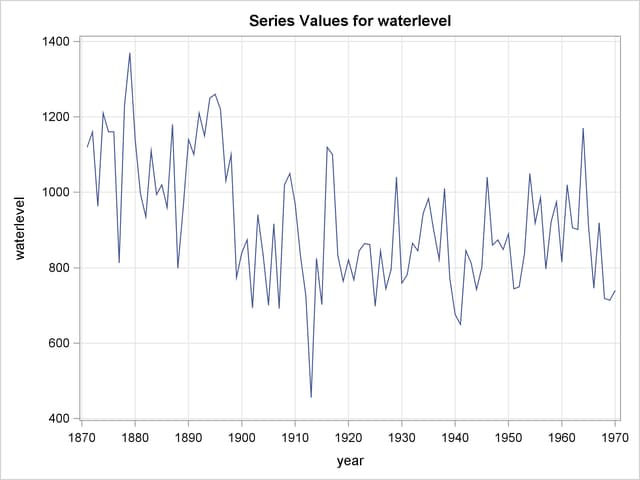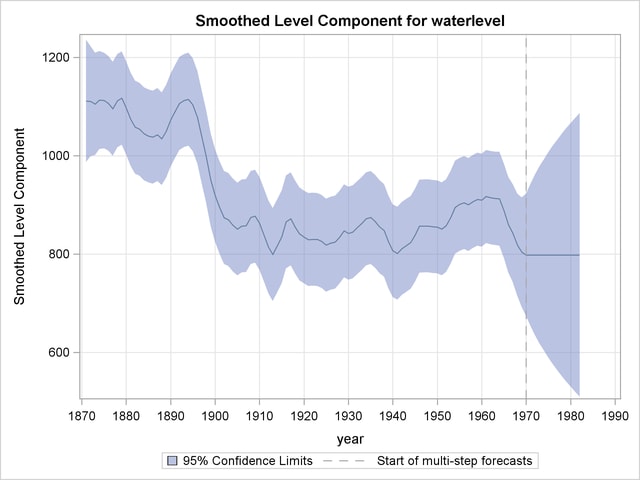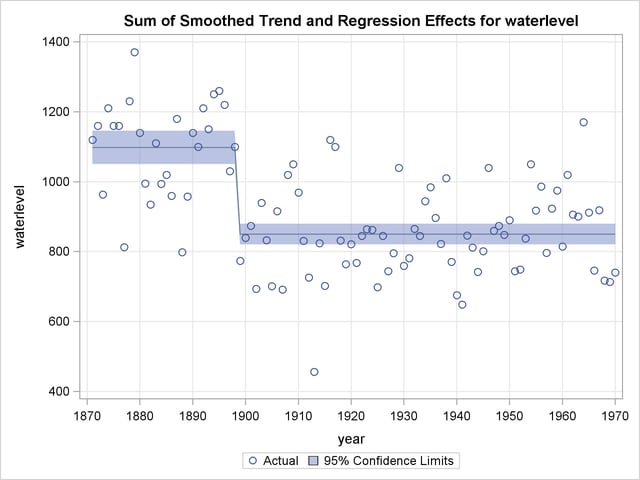| The UCM Procedure |
Example 31.7 Detection of Level Shift
The series in this example consists of the yearly water level readings of the Nile River recorded at Aswan, Egypt (see Cobb (1978) and de Jong and Penzer (1998)). The readings are from the years 1871 to 1970. The series does not show any apparent trend or any other distinctive patterns; however, there is a shift in the water level starting at the year 1899. This shift could be attributed to the start of construction of a dam near Aswan in that year. A time series plot of this series is given in Output 31.7.1. The following DATA step statements create the input data set.
data nile; input waterlevel @@; year = intnx( 'year', '1jan1871'd, _n_-1 ); format year year4.; datalines; 1120 1160 963 1210 1160 1160 813 1230 1370 1140 995 935 1110 994 1020 960 1180 799 958 1140 1100 1210 1150 1250 1260 1220 1030 1100 774 840 874 694 940 833 701 916 692 1020 1050 969 831 726 456 824 702 1120 1100 832 764 821 768 845 864 862 698 845 744 796 1040 759 781 865 845 944 984 897 822 1010 771 676 649 846 812 742 801 1040 860 874 848 890 744 749 838 1050 918 986 797 923 975 815 1020 906 901 1170 912 746 919 718 714 740 ;
ods graphics on; proc timeseries data=nile plot=series; id year interval=year; var waterlevel; run;

In this situation it is known that a shift in the water level occurred within the span of the series, and its effect can be easily taken into account by including an appropriate indicator variable as a regressor. However, in many situation such prior information is not available, and it is useful to detect such a shift in a data analytic fashion. You can check for breaks in the level by using the CHECKBREAK option in the LEVEL statement. The following statements fit a simple locally constant level plus error model to the series:
proc ucm data=nile; id year interval=year; model waterlevel; irregular; level plot=smooth checkbreak; estimate; forecast plot=decomp; run;
The plot in Output 31.7.2 shows a noticeable drop in the smoothed water level around 1899.

The "Outlier Summary" table in Output 31.7.3 shows the most likely types of breaks and their locations within the series span. The shift of 1899 is easily detected.
The following statements specify a UCM that models the level of the river as a locally constant series with a shift in the year 1899, represented by a dummy regressor (SHIFT1899):
data nile; set nile; shift1899 = ( year >= '1jan1899'd ); run;
proc ucm data=nile; id year interval=year; model waterlevel = shift1899; irregular; level; estimate; forecast plot=decomp; run;
The plot in Output 31.7.4 shows the smoothed trend, including the correction due to the shift in the year 1899. Notice the simplicity in the shape of the smoothed curve after the incorporation of the shift information.

Copyright © SAS Institute, Inc. All Rights Reserved.